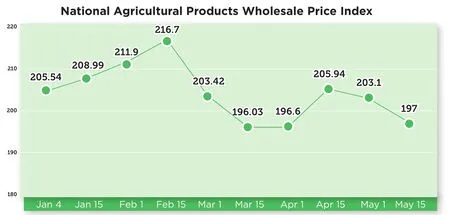A Worrying Trend
2013-12-07ByLanXinzhen
By Lan Xinzhen

SOWING HOPES: Farmers in Xinjian County, Jiangxi Province,manage rice seedlings in March. The slack in grain planting has led to growing concerns by the Central Government
Agriculture is an important foundation for China’s economic and social development, and grain security for 1.3 billion Chinese is the top priority of the government.This year, farm produce price fluctuations upset the planting and breeding industries,imposing tremendous pressure on the Chinese Government. On May 13, the Ministry of Agriculture (MOA) sent seven work groups to six major agricultural provinces across the country to help guide spring ploughing, pig raising and recovery of farm production in an earthquakeaffected area in Sichuan.
According to MOA figures, China’s farm production this year isn’t in good shape. In terms of grain planting, a total of 57.13 million hectares of cropland had been sown by May 9, a decline of 6 percentage points from last year. Of the total, 37.87 million hectares of grain land was sown, completing 60.2 percent of the planned acreage, which was 7.7 percentage points lower than a year ago; 3.2 million hectares of oil crop land was sown,accounting for 46.6 percent of the planned acreage and dropping by 4.3 percentage points than the same period last year. The breeding of pigs, which imposes the most direct influence on the consumer price index(CPI), seemed to face tremendous difficulty:Because pork prices kept dropping for two months while feedstuff prices remained unchanged, a farmer lost 200 yuan ($32.26) for each head of pig he fed.
Du Zhixiong, Deputy Director of Rural Development Institute at the Chinese Academy of Social Sciences, said there are many reasons to explain China’s gloomy agricultural situation. For one, the income from planting grain and breeding is lower than what farmers may earn as migrant workers in cities, leaving many to abandon farm work. Natural disasters and animal epidemic diseases also occurred in some areas, and the April 20 earthquake in Lushan, Sichuan Province, seriously impacted local agricul-tural production.
“To prevent demand and supply as well as the prices of farm produce from fluctuating wildly is an urgent need for present agricultural situation. The government should thereby shore up the confidence of farmers, promote sustained and sound economic development and increase farmers’income,” Du said.
Government measures
At a State Council executive meeting chaired by Premier Li Keqiang on May 8, the cabinet discussed ways to boost agricultural production and ensure market supplies and stable prices.
According to a report from gov.cn, the meeting concluded with five measures needed to ensure the stable prices of farm produce. First, local governments must better manage the sowing of grain crops in order to create the favorable conditions needed for a bumper harvest in the coming fall. Second, related government departments must support the large-scale production of pigs. Third, large-scale breeding farms are needed to increase supplies of beef and mutton. Fourth, the State Council will further expand the poultry industry. Fifth,a recovery is needed in the Lushan earthquake-affected area to restore facilities and farmland destroyed by the quake.
Du thinks the most important task in grain production is to ensure the sowing acreage is not reduced. In 2012, China’s grain output increased by 3.2 percent to reach 589.57 million tons, realizing nine consecutive years of growth.Despite a bumper harvest, China still imported 13.98 million tons of grain in 2012. If the sowing acreage of grain reduces this year, grain output will then reduce, exacerbating China’s dependence on imported grain, an unfavorable situation for China’s food security.
This year the Central Government will strengthen incentives to major grain and oil crop producing counties, raising their output bonuses by 20 percent from 2012 levels. In 2012, it offered 28 billion yuan ($4.52 billion) of bonuses to large grain and oil crop producing farmers and companies.
Related departments have also formulated measures to support pig breeding. On May 9 the Ministry of Commerce (MOFCOM),the National Development and Reform Commission and the Ministry of Finance began the purchase of frozen pork reserves to stabilize pork prices. A total of 93,700 tons of pork will be purchased.
The MOFCOM says it will closely cooperate with other related ministries and commissions in following pork production and price fluctuations and adopt measures to ensure balanced demand and supply and stable pork prices.
Will the measures work?
Regarding measures to ensure stable pork prices and balanced supply and demand, Hao Jun,an agricultural analyst with Guodu Securities Co. Ltd., said time is needed to judge how these measures will benefit grain production.

(Source: Ministry of Agriculture)
According to Hao, in China, major grain production areas are responsible for guaranteeing the country’s grain security. However,since GDP is the most important indicator evaluating the performance of local officials,various local governments have become too focused on GDP growth. Because the economic benefits of planting grain are low, officials in major grain production areas prefer attracting foreign investment to the grain production business. In some places,governments have even changed cultivated land into land for industrial purposes, reducing the sowing area for grain. Policies that encourage grain planting will ultimately fail unless local governments shift their way of thinking, said Hao.
According to the MOA, on May 13 the average price of pork stood at 17.93 yuan ($2.89)per kg, a decline of 2 percent from just a few days earlier. The news that the government was expanding its pork reserves did nothing to bring favorable change.
In 2009 and 2011, pork prices both stopped their decline after the government purchased reserves and the policies at that time soon stabilized prices. However, prices failed to rise in 2012 and 2013 after the government purchased reserves. According to Hao’s analysis, when the policy of purchasing pork was first initiated, it led to expectations among pig breeders that pork prices would rise. But after several versions of the policy have been adopted to little effect, expectations have been lowered.
He added that purchasing reserves affects prices down the road and doesn’t have an immediate impact. Although pig breeders have been losing money for two months,they are not killing sows, or female pigs, in large numbers, and the cost of piglets remains high. That means in fall and winter,when pork consumption is high, the price of live pigs is expected to rise slowly and allow pig farmers to make money. The pork supply also won’t be tight and prices won’t soar.
The price of pork is an important part of China’s CPI. According to Hao, the CPI rose faster in April than in March, and the major reason was the hike of vegetables. But because the fall in pork prices offset the hike in vegetables, the CPI did not fluctuate remarkably.
Hao is optimistic about food prices this year.“For all of 2013, China’s farm produce prices,including pork and grain, will be stable.” ■
